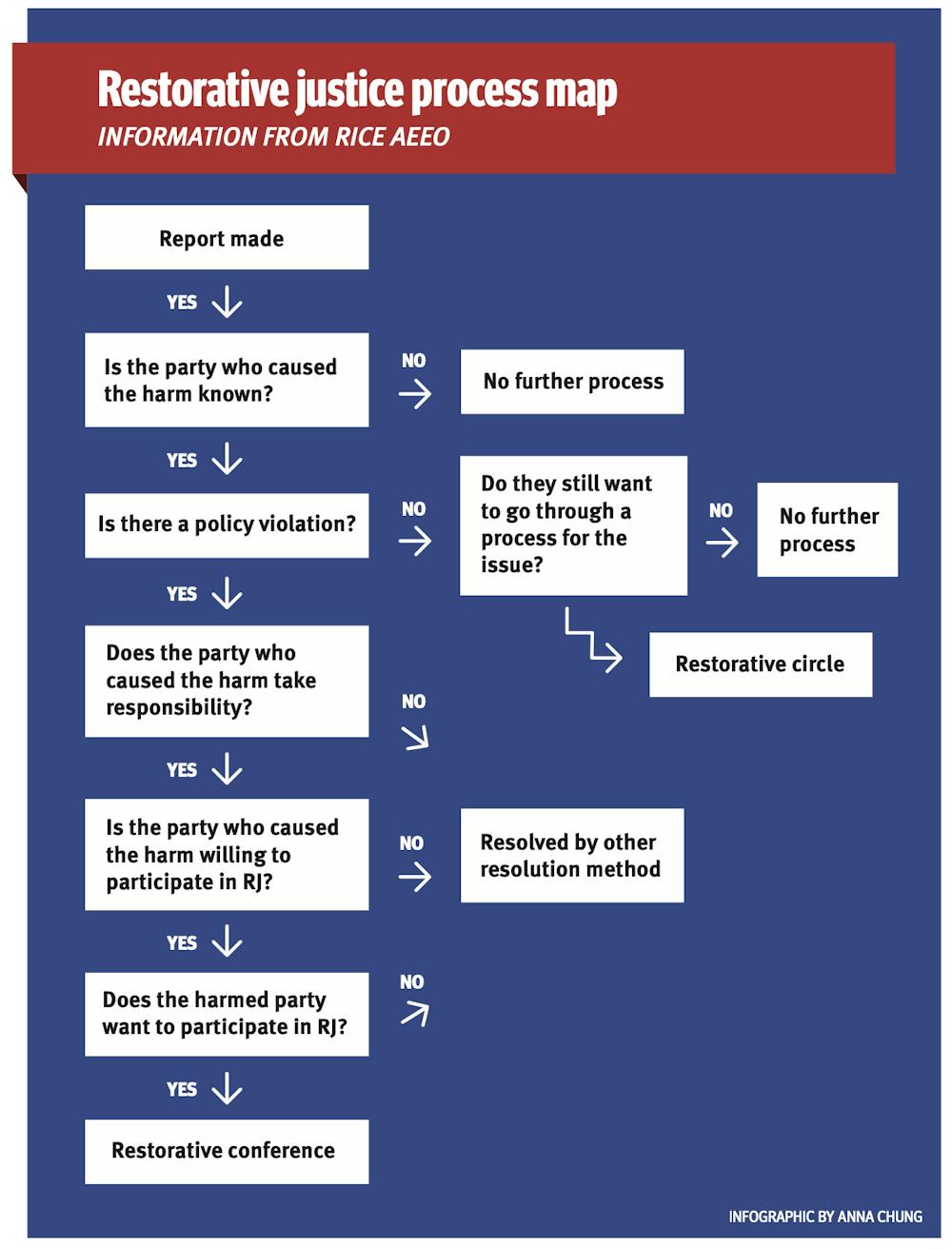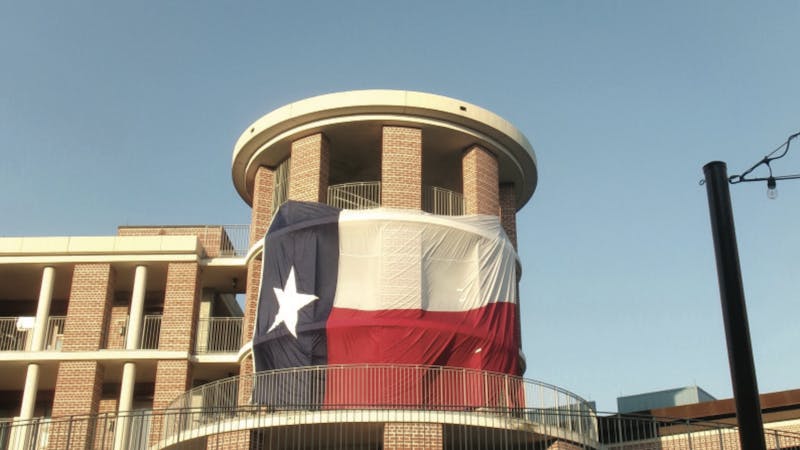Rice offers restorative justice as alternate resolution

Infographic by Anna Chung
Rice began offering restorative justice as an alternative option for informal dispute resolution this fall semester, according to Olivia Hernandez, equal opportunity specialist for the Office of Access, Equity and Equal Opportunity.
Restorative justice aims to provide an opportunity for students to address harms and complaints outside of the traditional resolution process, according to the AEEO’s restorative justice plan. The program will allow accused students to take responsibility for their actions and help restore community bonds, according to Hernandez.
Restorative justice will only be provided as an option for cases that are appropriate for resolution as defined by Policy 828, according to Hernandez.
Conversations about implementing restorative justice as an alternative option began when Title IX rewrites occurred over the summer in response to the Department of Education’s Title IX changes, according to Anastasia Newheart, president of Graduate Students Transforming Rice Into a Violence-Free Environment. Newheart said that the addition of the live hearing requirement under the Trump administration caused concerns among students.
“People were really concerned about that being a deterrent,” Newheart said. “Though I have been interested in [restorative justice] for a few years, so this is something that I thought would be beneficial to Rice.”
Hernandez said that this semester will be the pilot phase of the restorative justice program. Currently, there is a limitation on the types of cases that could be restorative justice cases due to limitations in resources.
“For sexual assault cases, particularly ones that involve a lot of violence, right now, restorative justice would not be an option for that,” Hernandez said. “For example, if it’s sexual harassment and people sent texts that bothered someone, maybe that’s an [restorative justice] case.”
Restorative justice involves both the party who was harmed and the one that caused the harm to engage in a conversation with a trained facilitator, according to Hernandez. Both parties must agree to participate, and the one who caused harm must take responsibility for their actions, which is not a requirement under the formal resolution process.
“The person who was harmed is able to say what they think the correct way to repair the harm is, and then the facilitator and the parties work to create this agreement on how to repair the harm,” Hernandez said.
The conversation is followed by a resolution agreement, which is a contract between the two parties that has to be followed. Agreements will also be followed up on to make sure that the party who caused the harm complies with the resolution agreement, according to Hernandez.
Hernandez said that she hopes that within the next few semesters, the restorative justice program will expand to take on more cases and other departments at Rice will implement the program, such as the Office of Multicultural Affairs.
The Committee for Intimate Partner Violence and Sexual Assault Prevention and Survivor Support is working with the AEEO to provide ongoing student feedback for the current restorative justive framework, according to Hernandez. Jacob Tate, IPVP director, said that the IPVP committee completely supports the RJ initiative.
Disclaimer: Jacob Tate is a senior writer for the Thresher Arts & Entertainment section.
“Our current [punitive] methods not only fail to create any kind of justice or resolution for victim survivors but also require retraumatization in the name of ‘proof,’” said Tate, a Sid Richardson College senior. “Additionally, punitive methods cause responding students to double down and not consider the harms of their behavior, meaning that when they are typically found innocent, there is no instance of rehabilitation.”
At this point, the AEEO does not plan on using restorative justice with cases that involve higher degrees of violence because of the retraumatization that may occur as a result, Hernandez said.
“When you get into a position where you’re using restorative justice for cases that involve a higher degree of violence, you’re running a higher risk of victimization and particularly increasing the trauma of the situation,” Hernandez said.
Newheart said she believes that with proper resources and experienced facilitators, restorative justice can be used for most cases of sexual assault, if parties agree to that option. Newheart said that the expansion of restorative justice will depend on the resources that Rice is willing to put into it.
“If we had a facilitator who had the appropriate experience to deal with that kind of traumatic situation, I would want to have that as an option for survivors,” Newheart said.
Tate said that the IPVP committee and others working on restorative justice are working to ensure that the process does not produce greater harm.
“Our committee and other individuals working on [restorative justice] are working to ensure that this voluntary process neither retraumatizes accused students nor lets responding students off the hook for their harms,” Tate said.
Newheart said that she understands why students may be hesitant to use restorative justice as a resolution method because it is a new process that is very different from the traditional punitive system.
“The goal of a punitive system is to punish that person, but the goal of a restorative justice system is to repair them,” Newheart said.
Newheart said she believes more educational outreach needs to be done to inform students about this process and exactly how it works. Newheart said that some people may not be comfortable with restorative justice as an option, so it is never going to be forced onto students.
“I totally understand that for some people this just may not be the right option for them, and I respect that,” Newheart said. “This is going to be totally situation and context dependent. The point here is to give someone more options not to pressure them into doing something [they are] not comfortable with.”
More from The Rice Thresher
Rice lands high on Niche, Forbes college ranking lists
Rice recently ranked No. 10 on Niche’s Best Colleges in America list and No. 12 on Forbes’ annual America’s Top Colleges list in 2026. It was also recognized in several categories by the Princeton Review, placing in the top 10 in four categories.
From post-human novels to augmented reality, Rice hires new faculty
Rice welcomed 97 new professors this fall across disciplines, including a posthumanist Harvard scholar, a husband-wife duo and a computer science professor who graduated from Rice thrice.

First public of the year reckons with threats of a dry campus
After a Dis-O that saw four times as many calls for intoxication-related transports of students to the hospital compared to the prior three years, Cory Voskanian, a Martel College socials head tasked with planning the first public of the year, said that he was feeling the pressure.


Please note All comments are eligible for publication by The Rice Thresher.